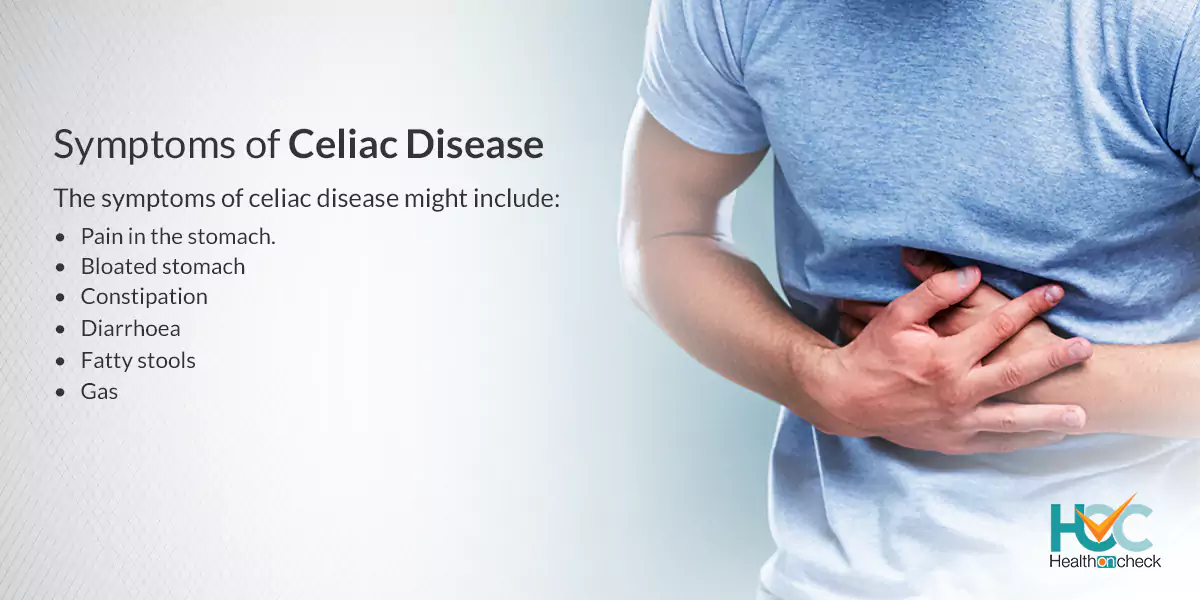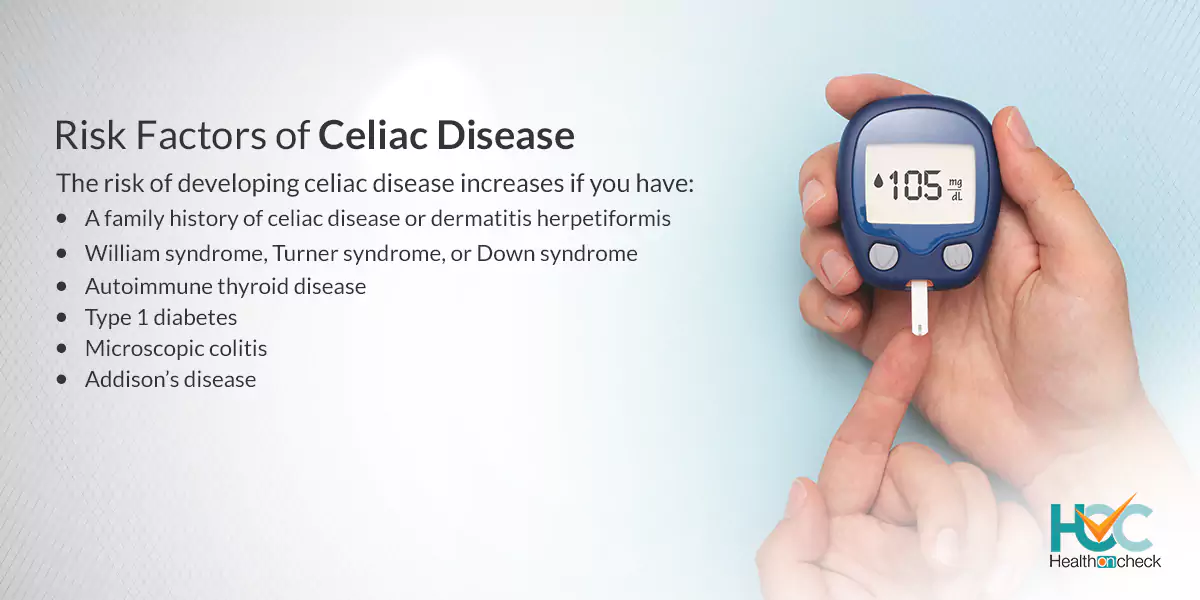What is Celiac Disease?

Celiac disease is a health condition that occurs because of an immune reaction to eating gluten. Gluten is a protein found in grains such as barley, wheat, or rye. If you have celiac disease and you eat foods containing gluten then it will trigger an immune response to the gluten protein in your small intestine. Over some period, this reaction will damage your small intestine’s lining and stop it from absorbing nutrients, a condition known as malabsorption. The intestinal damage usually results in various symptoms including diarrhoea, weight loss, fatigue, anaemia, or bloating. If not treated or managed then it can cause serious complications. Malabsorption can affect growth and development in children along with gastrointestinal symptoms.
What are the Types of Celiac Disease?
There are 3 common types of celiac disease: classical, non-classical, and silent celiac disease. Each of these types has more or less similar symptoms, though the symptoms can vary in severity.
– Classical celiac disease
In instances of classical celiac disease, early warning signs might include:
– Digestive symptoms and complications
– Diarrhoea
– Unintended weight loss
– Developmental issues in children
For people who are suffering from classical celiac disease but still consuming gluten, there is a big chance that they will produce smelling, pale, and fatty stools. This condition is called steatorrhea.
– Non-classical celiac disease
In instances of non-classical celiac disease, early warning signs might include:
– Abdominal bloating and cramping
– Persistent fatigue
– Severe headaches
– Tingling in the feet or hands
– Anaemia
– Decreased bone mass
– Dental problems
– Itchy rash on the body
Note: The key difference between classical and non-classical celiac disease is that people with classical celiac disease have symptoms of malabsorption whereas those with non-classical celiac disease might not experience tell-tale symptoms of malabsorption.
– Silent celiac disease
In the case of silent celiac disease, people will not experience any symptoms linked with celiac disease. If you are wondering how someone can still have celiac disease but not experience symptoms when they consume gluten. It’s because people with silent celiac disease will experience villous atrophy damage to their small intestine, but can live their life feeling normal.
What are the Symptoms of Celiac Disease?
The symptoms of celiac disease vary according to person to person, thus making it difficult to recognize. Some people don’t experience any symptoms at all while a few might experience indigestion and other gastrointestinal symptoms after eating foods containing gluten. A few might only have mild symptoms of nutritional deficiencies later on after real damage has been done. In such people, symptoms of anaemia might be the first to appear.
The symptoms of celiac disease might include:
Gastrointestinal symptoms, including:
– Pain in the stomach.
– Bloated stomach.
– Gas.
– Constipation.
– Diarrhoea.
– Fatty stools.
Symptoms of iron-deficiency anaemia, including:
– Weakness.
– Fatigue.
– Pale complexion.
– Cold hands.
– Brittle nails.
– Headache.
– Mouth sores.
Other symptoms of malnutrition, include:
– Unexpected weight loss.
– Growth problems children.
– Low muscle mass.
– Dental enamel problems.
– Abnormal periods
– Problems in getting pregnant.
– Mood changes, usually depression in adults and irritability in children.
Dermatitis herpetiformis: Nearly 15% of people suffering from celiac disease develop dermatitis herpetiformis, a chronic skin condition as a side effect. Also known as the “gluten rash” or the “celiac rash,” the same gluten antibodies that harm your small intestine in celiac disease cause this complication. Dermatitis herpetiformis causes an itchy rash in your body that looks like clusters of bumps or blisters. It generally impacts your elbows, scalp, knees, or buttocks.
What are the Causes of Celiac Disease?
The exact cause of celiac disease is unknown, though your genes, in combination with eating foods containing gluten and other factors, can prompt celiac disease. Infant-feeding practices, gastrointestinal infections, and gut bacteria might also trigger celiac disease, but they have not been proven yet. Many develop celiac disease after viral infection, surgery, pregnancy, childbirth, or serious emotional stress.
When the body’s immune system starts overreacting to gluten in food, it damages the small, hairlike projections, known as villi, lining the small intestine. Villi absorbs minerals, vitamins, and other nutrients from the food you consume. When your villi are damaged, you are not able to absorb enough nutrients, irrespective of how much you eat.
What are the Risk Factors of Celiac Disease?
The risk of developing celiac disease increases if you have:
– A family history of celiac disease or dermatitis herpetiformis.
– Type 1 diabetes.
– William syndrome, Turner syndrome, or Down syndrome.
– Autoimmune thyroid disease.
– Microscopic colitis.
– Addison’s disease.
What are the Complications of Celiac Disease?
The complications of celiac disease include:
– Cancer, such as small bowel cancer or intestinal lymphoma.
– Damaged tooth enamel
– Miscarriage
– Infertility
– Lactose intolerance
– Malnutrition
– Nervous system problems
– Pancreatic disease
– Weak bones
How Celiac Disease is Diagnosed?
Most of the people with celiac disease are unaware that they have celiac disease:
One of the main procedures to diagnose celiac disease is serology testing which detects antibodies in your blood. Increased levels of a few specific antibody proteins signify an immune reaction to gluten.
The symptoms of celiac disease are similar to some other diseases and genetic testing for human leukocyte antigens (HLA-DQ2 and HLA-DQ8) is usually used to rule out celiac disease.
It is quite vital to be tested for celiac disease before going for a gluten-free diet. Removing gluten from your diet may make the results of blood tests appear in the standard range.
If the results of these tests indicate celiac disease, one of the following tests might be prescribed:
– Endoscopy
A tiny camera is used in this test which is inserted into your mouth and passed down your throat. The camera allows your doctor to view the small intestine and take a small tissue sample, called a biopsy, to examine for damage to the villi.
– Capsule endoscopy
Here a tiny wireless camera is used to take pictures of your entire small intestine. The camera is put under a vitamin-sized capsule, which you need to swallow. As the capsule passes through your digestive tract, the camera takes thousands of pictures and then these pictures are transmitted to a recorder. This test is used in cases where an exam of the entire or end of the small intestine is needed.
For instance, if you have dermatitis herpetiformis, your doctor might collect a small sample of skin tissue to examine under a microscope.
If you’re diagnosed with celiac disease, some more tests might be prescribed to check your nutritional status including checking the levels of vitamins A, B-12, D, and E, along with mineral levels, hemoglobin, and liver enzymes. Your bone health might also be checked with a bone density scan.
What are the Treatment Options Available for Celiac Disease?
If you are diagnosed with celiac disease then your doctor will first ask you to stop eating gluten. You can’t change the way your body reacts to gluten, but you can prevent gluten from prompting that reaction. After you stop consuming gluten, your small intestine will start to heal and it will soon start absorbing nutrients again. You need to maintain a strict gluten-free diet throughout your life to avoid hurting your small intestine again.
Additional treatment might include:
– Nutritional supplements for replacing any severe deficiencies.
– Certain medications are given to treat dermatitis herpetiformis.
– Corticosteroids for serious inflammation.
– Continuous follow-up care is needed along with regular testing to ensure the disease is controlled.
Living with Celiac Disease?
If you are diagnosed with celiac disease diagnosis then your diet and lifestyle will change forever but for the better. Before diagnosis, you were almost certainly eating gluten which was damaging your small intestine. You might experience strange and uncomfortable symptoms for years without knowing that you have celiac disease. After diagnosis, it’s totally in your hands to restore your health.
Whom to Consult?
If you have diarrhoea or digestive discomfort lasting for more than 14 days then you should consult with your doctor. Also consult your child’s doctor if your child shows symptoms such as paleness, development issues, irritability, and foul-smelling, bulky stools. If you have a family history of celiac disease or type 1 diabetes, then also you should get yourself checked because these factors increase the risk of celiac disease.






